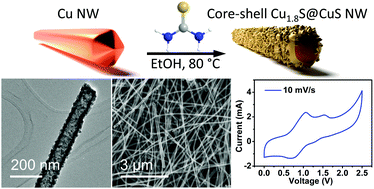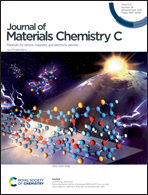Synthesis and characterization of ultralong copper sulfide nanowires and their electrical properties†
Abstract
We report the synthesis of ultralong copper sulfide nanowires (Cu2−xSNWs) through the sulphidation reaction of metallic copper nanowires (CuNWs) by thiourea under mild conditions. The multiscale characterization of Cu2−xSNWs revealed the presence of a core shell structure made up of an external covellite layer coating a roxbyite core. The Cu2−xSNWs, exhibiting lengths as high as 200 μm, can be easily dispersed in ethanol and deposited onto arbitrary substrates such as glass or plastic. The resulting films are readily conducting without the need for post-treatments and exhibit a sheet resistance of 4.1 kΩ sq−1 at 73.7% transmittance (at 550 nm), by virtue of the high aspect ratio of the Cu2−xSNWs. The multiscale electrical characterization down to the single Cu2−xSNWs revealed a low resistivity of 6.9 × 10−6 Ω m and perfect Ohmic conductivity. Interestingly, the conductivity of Cu2−xSNW films supported on polyethylene naphthalate sheets remained almost unaltered (4% decrease) after 10 000 bending cycles. In addition, Cu2−xSNWs have shown excellent chemical stability towards a strong oxidant like FeCl3 as well as in an acidic environment. Finally, Cu2−xSNWs have been employed as active materials in symmetric supercapacitors revealing good pseudocapacitive behaviour, with specific capacity as high as 324 F g−1 (at 5 mV s−1) and 70% retention of the initial capacitance after 5000 cycles (at 100 mV s−1).



 Please wait while we load your content...
Please wait while we load your content...